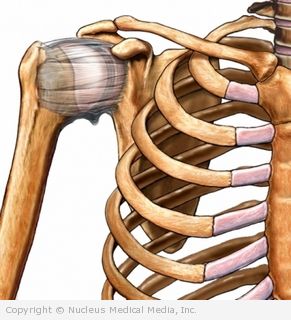Shoulder sprain
Shoulder sprain – Definition
A shoulder sprain is stretching or partial tearing of the ligaments and capsule that support the shoulder, specifically, the glenohumeral joint. Ligaments are strong bands of tissue that connect bones to each other. The glenohumeral joint is the meeting of the upper arm bone, humerus, and the cup of the shoulder blade.
The major ligaments of the glenohumeral joint are the superior, middle and inferior glenohumeral ligaments, and they serve to stabilize the highly mobile joint. The capsule of the glenohumeral joint is thinner tissue that encloses and supports the shoulder joints.
An acute mild injury to the glenohumeral ligaments can be considered a shoulder sprain. More severe injury can result in dislocation.
Shoulder sprain – Causes
Shoulder sprains involving the glenohumeral joint may be caused by:
- Falling on an outstretched arm
- Forced twisting of the arm
- A blow to the shoulder
Shoulder sprain – Risk Factors
A risk factor is something that increases your chance of getting a disease, condition, or injury. Risk factors for shoulder sprain include:
- Playing sports
- Poor coordination
- Poor balance
- Inadequate flexibility and strength in muscles and ligaments
- Loose joints or connective tissue disorders
Shoulder sprain – Symptoms
Symptoms of shoulder sprain may include:
- Pain, tenderness, and swelling around the shoulder
- Redness, warmth, or bruising around the shoulder
- Limited ability to move the shoulder and increased pain with movement
Shoulder sprain – Diagnosis
The doctor will ask about your symptoms and how you injured your shoulder. The doctor will examine your shoulder to assess the stability of the joint and the severity of the injury.
Tests may include:
- X-rays — to make sure that no bones are broken or displaced
- MRI scan — to see the extent of damage to the soft tissue of the shoulder (rarely needed)
- Arthrogram — another type of imaging test
Shoulder sprain – Treatment
Treatment includes:
- Rest — Avoid using your injured arm.
- Ice — Apply ice or a cold pack to the shoulder for 15-20 minutes, four times a day for at least 2-3 days. This helps reduce pain and swelling. Wrap the ice or cold pack in a towel. Do not apply the ice directly to your skin.
- Medication — First, consult your doctor if you have any questions about using medicines. Common over-the-counter medicines include: ibuprofen, naproxen, acetaminophen, and aspirin. Also available are topical pain medicines (eg, creams, patches) that are applied to the skin.
- Brace or sling — You may need to wear a sling to immobilize your arm and shoulder. If you play sports, you may need to wear a shoulder brace when you return to play.
- Rehabilitation exercises — Begin exercises to restore flexibility, range of motion, and strength in your shoulder as recommended by your healthcare professional. Sometimes electrical stimulation is used to aid recovery.
- Surgery — is not always needed to repair a mild shoulder sprain without instability or dysfunction. In certain athletes, earlier surgery may be considered to avoid recurrent injury.
Shoulder sprain – Prevention
To reduce your risk of spraining a shoulder:
- Do exercises to strengthen arm, back, and chest muscles.
- Learn the proper technique for exercise and sporting activities. This will decrease stress on all your muscles, ligaments, and tendons, including those around your shoulder.

